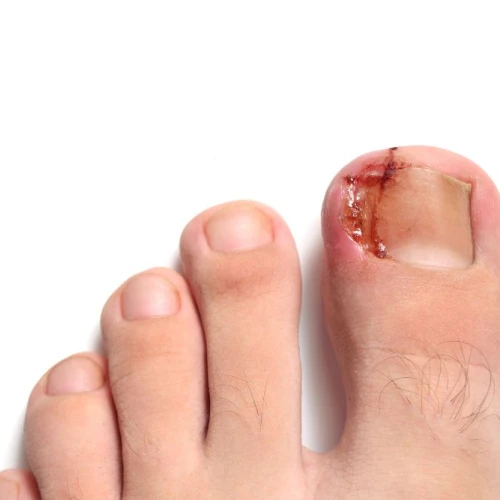Ingrown nails are a common problem that mostly affects the toenails, especially the big toe. The nail grows abnormally into the skin. Ingrown toenails also be caused by a rapid growth of skin around the nail.
What are the symptoms of an ingrown toenail?1
An ingrown toenail is a nail that becomes embedded in the flesh. This conflict between the nail plate (the nail) and the periungual tissue (the skin surrounding the nail) causes inflammation of the tissue around the nail. The area can become infected if not treated at an early stage.
Inflammation results in:
- Pain in the skin around the nail, especially if pressure is exerted;
- Redness and swelling around the nail;
- A cut in the skin in some cases;
- A bulge around the nail.
If left untreated, the symptoms will gradually worsen. The pain, which initially is moderate, intermittent and only felt when wearing closed shoes or doing sport, will worsen and become almost permanent. Wearing closed shoes makes the situation worse and even make walking difficult. Exerting pressure on the swollen skin (i.e. the bulge) is very painful.
Intense and throbbing pain is indicative of an infected ingrown toenail. Another characteristic sign of infection is the presence of pus between the tip of the ingrown nail and the skin, an area called the “periungual fold”. If an ingrown nail is left untreated, the bulge will swell and become a large red bump resembling a raspberry, called a pyogenic granuloma. At this stage of infection, walking is difficult and painful and the risk of falling increases.
What causes an ingrown toenail?1
Several factors contribute to the development of ingrown toenails.
Not looking after your nails properly
Ingrown toenails are generally caused by badly cut nails. A well-cut nail is one that is square cut whose free edge (the top of the nail) only protrudes by two to three millimetres. An ingrown toenail can occur if the nail is cut in a semi-circle or too short around the edges, as skin can cover the edge of the nail and, in such cases, will tend to grow into the dermis.
Leaving a small nail spike in the periungual groove (the small space between the edge of the nail and the surrounding skin) is another risk factor for an ingrown toenail.
Wearing very tight shoes
Wearing very tight shoes increases the risk of an ingrown toenail. Tight shoes exert pressure on the toenails and make the feet sweat more, which both can cause ingrown toenails.
Some foot conditions
Some foot conditions increase the risk of an ingrown toenail:
- Bone changes in the foot due to osteoarthritis (e.g. bunion);
- Static disorders of the foot caused by heel pain, corns, osteoarthritis of the foot or crossover of the first and second toes (when the second toe overlaps the first).
Nail abnormalities
Nails tend to become ingrown more readily if:
- They are deformed or abnormally thick, e.g. due to a fungal nail infection.
- The surrounding skin has thickened.
- Trauma (e.g. intense impact) has occurred, including broken nails resulting in a nail shard becoming embedded in the flesh.
Some conditions
Some conditions, such as diabetes, can change the composition of nails, due to reduced blood flow and sensitivity.
How do you treat an ingrown nail ?2,3
Can an ingrown nail heal on its own?
You can treat an ingrown nail without consulting a doctor as long as the ingrown nail is only inflamed (i.e. bearable pain and no pus in the periungual fold).
To treat your ingrown nail at home:
- Immerse your foot in hot water for 10 to 20 minutes, three times a day.
- Apply a topical antiseptic to the inflamed area several times a day.
- Place a cotton wick between the corner of the ingrown nail and the skin to separate the nail from the flesh.
- Keep the ingrown toenail exposed to the air as much as possible.
- Wear open-toed or wide shoes to let your toes move freely when walking. Do not wear high heels or mules, as this type of footwear places greater stress on the forefoot.
- Keep your feet dry by wearing cotton shoes and socks, as cotton is much better at absorbing perspiration.
- As the ingrown nail grows, make sure it is cut straight. Ideally, the free edge of the nail should extend by two to three millimetres.
- If you wear stockings or tights, make sure they have an open end to avoid compressing your toes.
In most cases, these measures will be enough to heal an ingrown toenail. The pain will gradually decrease, and the bulge will disappear spontaneously within a few days.
When do you need medical treatment?
See a doctor if the treatments at home have not healed the ingrown nail. Doctors can prescribe:
- Topical antiseptic treatment used in a footbath or applied topically;
- Antibiotics if the periungual area is infected;
- Podiatry care.
When should you see a podiatrist for ingrown nails?
Podiatrists can help with ingrown nails if the pain is unbearable and walking is difficult, for rapid pain relief. A podiatrist is able to relieve the pressure of the ingrown nail by lifting the portion embedded in the flesh. This involves inserting cotton wicks at the posterior edges of the nail, cutting the nail wide enough to remove the spikey tip and, in some cases, applying silver nitrate with a pencil to speed up the healing process in the area around the nail.
To stop it happening again, the podiatrist may also use various techniques to change the natural curve of the nail. This is a lengthy process that can take several months. Finally, if there is a crossover between the first and second toes, the podiatrist can prescribe a toe separator.
Surgery as a last resort
Surgery is only considered when the ingrown toenail has not healed despite medical treatments and podiatric care. It is performed under local anaesthetic and involves:
- Removing part of the pulp or periungual area to release the nail;
- Or removing the portion of the ingrown toenail embedded in the skin by partially removing the matrix (i.e. the part that produces the nail).
Taking care of your feet to prevent ingrown toenails4
You can prevent ingrown toenails by taking care of your toenails and feet.
How to take care of your nails
It's best to cut your nails after a bath or shower, when they are softer, and sit down in a well-lit area. Cut straight across the nail, never in a semi-circle, leaving the free edge of nail only two to three millimetres in length. Use nail scissors and a cuticle cutter that have first been disinfected with alcohol. Never use instruments with a pointy tip to clean under the nails.
To reduce the risk of ingrown toenails, wear comfortable and open-toed shoes, wherever possible. Wear cotton socks to absorb perspiration, and massage your feet regularly (if you have a sensitive toe, you'll feel it).
How to take care of your feet
It is important to take care of your whole foot, not just the nails:
- Wash your feet every day and brush your nails to remove any thickened skin that may appear around them. You can also massage your toes regularly with a moisturising cream.
- Wear shoes and shocks that do not compress your toes.
- Do not wear high heels.
- Make sure your feet do not sweat excessively by wearing shoes and socks that allow your feet to breathe. If you have very sweaty feet, ask your chemist to recommend a suitable product.
Finally, monitoring conditions or disorders considered as risk factors (e.g. diabetes, bunions, nail trauma, etc.) can help prevent ingrown toenails.


